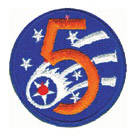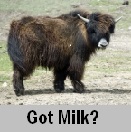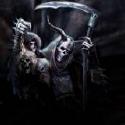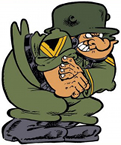wwengr
Posts: 678
Joined: 1/14/2007
From: Menomonee Falls, Wisconsin, USA
Status: offline

|
Back in WiTP, I put toghether a guideline on how I chose leaders. It was based on a Meta-analysis of posts by several people, including Mike Wood who gave significant insight into the game.
Any comments on below based on what may have changed for leaders in AE?
HQ Leaders
Command Headquarters
Combat Commands - Those in which significant and important battles occur within their command radius. Select leaders on the basis of these priorities:
- High Administration Skill - This influences the HQ units use of support to reduce fatigue and disruption
- High Land Skill - Influences the Assault Value of LCU's within their radius
- High Inspiration - Influences the Assault Value of LCU's within their radius
- All other skills have no influence or bearing on the HQ function.
Rear Area Commands - Those in which significant and important battles will not occur within their command radius. Select leaders on the basis of these priorities:
- High Administration Skill - This influences the HQ units use of support to reduce fatigue and disruption
- All other skills have no influence or bearing on the HQ function.
Corps/Army Headquarters
Front Line Corps' - Those in which significant and important battles occur within their command radius. Select leaders on the basis of these priorities:
- High Administration Skill - This influences the HQ units use of support to reduce fatigue and disruption
- High Land Skill - Influences the Assault Value of LCU's within their radius
- High Inspiration - Influences the Assault Value of LCU's within their radius
- All other skills have no influence or bearing on the HQ function.
Rear Area Corps' - Those in which significant and important battles will not occur within their command radius. Select leaders on the basis of these priorities:
- High Administration Skill - This influences the HQ units use of support to reduce fatigue and disruption
- All other skills have no influence or bearing on the HQ function.
Notes on Corps HQ Employment:
- Seek to put a corps HQ into or one hex from key battles
- Seek to put a Corps HQ in the hex with defensive bastions, invasions, and major assaults
- Corps HQ should only be used for rear area duties if you have more than you need for front line duties, then use them at designated R&R and Training bases.
- The Amphibious Corps HQ function as Corps HQ and not Amphibious HQ. This applies to the I, III, & V Amphibious Corps and not the III, V, & VII Amphibious Force.
Amphibious Force Headquarters
Select leaders on the basis of these priorities:
- High Land Skill - This influences the Amphibious Landings in that units will land faster, with less disruption and fewer losses
- All other skills have no influence or bearing on the HQ function.
Notes on Amphibious Force HQ Employment:
- Load these HQ's onto AGC's in their own TF set to Do Not Unload.
- Have the AGC TF arrive in the invasion landing hex in the same phase as the first wave landing TF's
- Keep them in the landing hex until the base is captured or the enemy is defeated, whichever comes first, then skeedaddle away to safety where the AGC will not get sunk. You only get three of these HQ's (if you are the allies...the Japanese get none). They will respawn, but better not tolose them too many times.
- Amphibious Force HQ do not function as Corps HQ. A good invasion should have a Corps HQ land with the invading forces.
Naval Headquarters
Select leaders on the basis of these priorities:
- The qualities and skills of the HQ leader has no influence or bearing on the HQ function.
- A Naval HQ is a good place for your stupidest, most incompetent admirals to become heroes
Notes on Naval HQ Employment:
- Place a Naval HQ in a forward repair depot. This will facilitate rapid repair and return to battle. A forward repair depot is a reasonably large port near the area of action. Reasonably large means size 5 or better so that damaged devices can be repaired.
- Place a Naval HQ far forward so that crippled ships in danger of sinking can slip into a nearby port within the HQ's range and enhance their chances of being saved.
- Place a Naval HQ in a Major repair shipyard to speed repairs (not sure if the HQ will exert an influence on a port that is already size 10).
- Most Naval HQ have naval support squads, so can assist in loading/unloading cargo and rearming ships.
Air Headquarters
Select leaders on the basis of these priorities:
- High Air Skill - This influences the number of strike and patrol aircraft that will fly.
- All other skills have no influence or bearing on the HQ function.
Notes on Air HQ Employment:
- Air HQ have a dramatic influence on level bombers. It is important to have an air HQ within range of your level bomber bases.
- Air HQ exert significant influence over other strike aircraft. It is good to have an air HQ in range of your bases from which strikes other than level bombers fly.
- Air HQ exert an influence over patrol aircraft. It is beneficial to have an air HQ in range of your bases with patrol aircraft.
- In Naval TF’s with Carriers (CV, CVL, CVE), the TF commander serves as the Air HQ for the carrier aircraft.
Note that the Leadership Value of Headquarters Commanders is completely irrelevant other than its influence on the Headquarters unit itself. That is it will influence how rapidly the HQ unit gains experience. The only value of the HQ Unit's experience is for its own defense. Therefore, do not bother installing your "strong leaders" in HQ Units. Look for the qualities that are specific to their function.
TF Leaders
Task Force Commander Selection
Task Force Commanders are selected in one of three ways:
- If Auto-select Commander is set to Off when the TF is formed, then the TF Commander is the captain of the Flagship.
- If Auto-select Commander is set to On, then the TF Commander is selected randomly from the pool of available RADM and VADM TF Commanders.
- After formation of the TF, the player may select the TF, if the TF is docked in a port, by clicking on the name of the TF Commander and selecting from the list of available RADM's and VADM's. This incurs a Political Point Cost.
Note: Rank has no bearing on the designation of the TF Commander. It is possible to create situations in which an Ensign is the TF Commander with ships/craft commanded by LTJG's and LT's and similar cases.
Flagship Selection
The Flagship of the Task Force is determined automatically using the following guidelines:
- Flagships are designated in order of Ship Class: AGC-CV-BB-BC-CVL-CA-CL-CLAA-CVE-DD (the list continues through all classes)
- Between ships of the same class, the largest ship in the task force (highest durability) is selected as the Flagship.
- For ships of the same class and equal durability, the last ship selected or added to the TF is the Flagship.
- The nationality of the Flagship determines the nationality of the TF and therefore the available pool of RADM and VADM to command the TF.
Air Combat TF
Select the TF Commander based on these qualities:
- Air Skill - The TF Commander functions as an Air HQ for the airgroups. This will influence how many atrike aircraft will fly.
- Aggression - Influences how likely the TF is to react and move toward an enemy. High aggression can result in your carrier group running into a fight. Be careful in this selection.
- Surface Skill - To save your hind quarters (and I am not talking Russian Helicopters), if you are unfortunate enough to get in a surface engagment.
- No other skills or qualities have any influence.
Surface Combat TF
Select the TF Commander based on these qualities:
- Surface Skill - To gain suprise and cross the T in an engagement
- Aggression - High Aggression will increase the likelyhood that the Surface Combat TF will react and seek a fight (be careful... A TF for two DD's with an Admiral of 100 agression will probably pick a fight with some BB's... This rarely ends well for the DD's)
- Air Skill - Of small import, but it influences the float plane operations from the Capital Ships.
- No other skills or qualities have any influence.
ASW Combat TF
Select the TF Commander based on these qualities:
- Surface Skill - Influences probability of finding submarines.
- No other skills or qualities have any influence.
Bombardment TF
Select the TF Commander based on these qualities:
- Aggression - Influences the probability that the TF will convert to a Surface Combat TF.
- Surface Skill - Influences TF in a fight the same as Surface Combat.
- Air Skill - Of small import, but it influences the float plane operations from the Capital Ships.
- No other skills or qualities have any influence.
Fast Transport TF
Select the TF Commander based on these qualities:
- Surface Skill - Influences TF in a fight the same as Surface Combat.
- Air Skill - Of small import, but it influences the float plane operations from the Capital Ships.
- No other skills or qualities have any influence.
Transport, Replenishment TF
Select the TF Commander based on these qualities:
- Surface Skill - Influences TF in a fight the same as Surface Combat. Also, it Influences probability of the escort combatants finding submarines
- Air Skill - Influences the operations of strike aircraft and float planes from the Escort Carriers and Cruisers.
- No other skills or qualities have any influence.
Mine Warfare YF
Select the TF Commander based on these qualities:
Surface Skill - Influences TF in a fight the same as Surface Combat.
Air Skill - Of small import, but it influences the float plane operations from the Cruisers.
No other skills or qualities have any influence.
Escort TF
Select the TF Commander based on these qualities:
- Surface Skill - If operating with the intent to engage surface combatants coming after the escorted TF, it Influences TF in a fight the same as Surface Combat. Also, it Influences probability of finding submarines
- Air Skill - Influences the operations of strike aircraft and float planes from the Carriers, Escort Carriers and Capital Ship.
- No other skills or qualities have any influence.
Notes on Selecting TF Leaders without assigning a leader:
- Using the Flagship Selection Criteria above, select the ship with the Captain that best fits type of TF being formed as Flagship so that he is the TF Commander.
- Any TF that is formed to perform any fighting function should have a competant Admiral assigned
Air Group Leaders
Selecting leaders for air groups is a fairly complex task. Most aircraft can perform multiple roles, so leader selection criteria must include consideration of how the air group will be employed.
Notes on Air Group Operations Influenced by Leader Qualities
- Pilot experience affects operational losses.
- Air groups with morale < 50 must pass a morale test before flying an offensive mission. If the test is failed, no aircraft will fly.
- Air groups flying Naval Search, ASW Patrol, or CAP must pass two morale tests before flying. Each morale test failed reduces the number of aircraft flying by 25%.
- Level Bombers must pass three tests before flying an offensive mission. Each test failed reduces the number of aircraft flying by 25%:
- Experience test.
- Test against the leader’s Air Skill.
- Morale test.
- Pilot experience affects the chances to find the target in a strike mission.
- Pilot experience affects air-to-air combat results.
- Leader’s air skill affects results in air-to-air combat.
CAP as Principle Role
This includes Fighters, Fighter-Bombers, Night-Fighters, and Float-Fighters. Assign leader using these priorities:
- Inspiration – Influences the number of CAP aircraft that will fly. Influences air group morale recovery.
- Air Skill – Influences the air-to-air combat results.
- Leadership – Influences the air group’s experience gain.
- No other skills or qualities have any influence.
Offensive Missions as Principle Role (except Level Bombers)
Missions include Airfield Attack, Port Attack, Naval Attack, Ground Attack, Sweep, and Recon. Air Groups include includes Fighters, Fighter-Bombers, Night-Fighters, Float-Fighters, Dive Bombers, Torpedo Bombers, Float Planes, Patrol, and Recon. Assign leader using these priorities:
- Inspiration – Influences the number of strike and patrol aircraft that will fly. Influences air group morale recovery.
- Leadership – Influences the air group’s experience gain.
- Air Skill – Influences results in air-to-air combat.
- No other skills or qualities have any influence.
Level Bombers with Offensive Missions as Principle Role
Missions include Airfield Attack, Port Attack, Naval Attack, Ground Attack, and Recon. Assign leader using these priorities:
- Inspiration – Influences the number of strike aircraft that will fly. Influences air group morale recovery.
- Air Skill – Influences the number of strike aircraft that will fly.
- Leadership – Influences the air group’s experience gain.
- No other skills or qualities have any influence.
Patrol Missions as Principle Role
Missions include Naval Search and ASW Patrol. Air Groups include Dive Bombers, Torpedo Bombers, Float Planes, level bombers, Patrol, and Recon. Assign leader using these priorities:
- Inspiration – Influences the number of patrol aircraft that will fly. Influences air group morale recovery.
- Leadership – Influences the air group’s experience gain.
- Of small import, Air Skill influences results in air-to-air combat (aircraft can be intercepted by CAP, but this is unlikely).
- No other skills or qualities have any influence.
Transport Missions as Principle Role
Missions include Supply Transport and Troop Transport. Air Groups include Transports, Patrol, and Level Bombers. Assign leader using these priorities:
- Inspiration –Influences air group morale recovery.
- Leadership – Influences the air group’s experience gain.
- Of small import, Air Skill influences results in air-to-air combat.
- No other skills or qualities have any influence.
Training Mission as Principle Role
This includes all air groups. Assign leader using these priorities:
- Inspiration –Influences air group morale recovery.
- Leadership – Influences the air group’s experience gain.
- Of small import, Air Skill influences results in air-to-air combat.
- No other skills or qualities have any influence.
Ship Leaders
Ship Captains
Carriers
This includes CV, CVL, and CVE. Assign leader using these priorities:
- Leadership – Influences the ship’s experience gain
- Air Skill – If the carrier captain will serve as the TF Commander, then he functions as the Air HQ for the TF aircraft. Air skill then influences the number of strike and patrol aircraft that will fly.
- Surface – Influences ship's chance of locating a target during surface combat
- No other skills or qualities have any influence.
ASW Vessels
This includes DD, DE, AVD, APD, DMS, MSW, PC, SC, & PG with ASW armament. Assign leader using these priorities:
- Leadership – Influences the ship’s experience gain
- Surface – Influences ship's chance of locating a target during surface combat
- No other skills or qualities have any influence.
Combat Vessels
All combat vessels with a high probability of surface combat that will be used in other than an ASW role. Assign leader using these priorities:
- Surface – Influences ship's chance of locating a target during surface combat
- Leadership – Influences the ship’s experience gain
- Air Skill – Of very small import. If the ship captain will serve as the TF Commander in a combat task force, then he functions as the Air HQ for the TF float planes. Air skill then influences the number of strike and patrol aircraft that will fly.
- No other skills or qualities have any influence.
Non-Combat Vessels
Assign leader using these priorities:
- Leadership – Influences the ship’s experience gain
- Surface – Influences ship's chance of locating a target during surface combat
- Air Skill – Of very small import. If the ship captain will serve as the TF Commander in a non-combat task force containing and operating float planes (i.e. Japanese AV with float planes loaded), then he functions as the Air HQ for the TF float planes. Air skill then influences the number of strike and patrol aircraft that will fly.
- No other skills or qualities have any influence.
Submarines
Assign leader using these priorities:
- Aggression – Influences sub’s chance of contacting enemy TF’s
- Surface – Influences sub’s chance of contact and survivability in an ASW attack
- Leadership – Influences the ship’s experience gain
- Air Skill – A curious consideration only. The captain of a Japanese submarine that will serve as the TF Commander in a sub patrol task force containing and operating float planes (i.e. E14Y1 Glen's on Types J3, A1, B1, A2, B2, B3/4, AM, or STo), then he functions as the Air HQ for the TF float planes. Air skill then influences the number of strike and patrol aircraft that will fly.
- No other skills or qualities have any influence.
Land Unit Leaders
LCU leaders should be selected based on how the LCU is being employed.
HQ Units
Assign HQ Unit Leaders using the criteria for HQ units. As considerations beyond the HQ unit’s function, use the following in order of priorities:
- Inspiration – Influences fatigue reduction, morale reduction due to fatigue, disabled elements destroyed due to fatigue, and assault value for attack and defense.
- Leadership – Influences experience gain.
- Administration – Influences ability to use Supply to reduce Disruption and Fatigue.
- Land Skill – Influences attacking & defending LCU assault value, firing accuracy and experience gain.
- No other skills or qualities have any influence.
Front Line Units (high probability of combat)
Assign unit leaders using the following order of priorities:
- Land Skill – Influences attacking & defending LCU assault value, firing accuracy and experience gain.
- Inspiration – Influences fatigue reduction, morale reduction due to fatigue, disabled elements destroyed due to fatigue, and assault value for attack and defense.
- Leadership – Influences experience gain.
- Administration – Influences ability to use Supply to reduce Disruption and Fatigue.
- No other skills or qualities have any influence.
Rear Area Units Training or Rear Area Functional Units
Units can use training to gain experience up to an allowable maximum based on the unit nationality. If unit is in the rear area in order to train, assign unit leaders using the following order of priorities:
- Leadership – Influences experience gain.
- Administration – Influences ability to use Supply to reduce Disruption and Fatigue.
- Inspiration – Influences fatigue reduction, morale reduction due to fatigue, disabled elements destroyed due to fatigue, and assault value for attack and defense.
- Land Skill – Influences attacking & defending LCU assault value, firing accuracy and experience gain.
- No other skills or qualities have any influence.
Rear Area Units Refitting
Units can be moved to a rear area to reconstitute (ideally out of a malaria or cold zone or in a base large enough to negate the effects). If the units are in the rear area to restore disabled elements, reduce fatigue, and replace lost elements, assign unit leaders using the following order of priorities:
- Administration – Influences ability to use Supply to reduce Disruption and Fatigue.
- Inspiration – Influences fatigue reduction, morale reduction due to fatigue, disabled elements destroyed due to fatigue, and assault value for attack and defense.
- Leadership – Influences experience gain (this is unimportant if the unit has already reached the maximum training experience).
- Of small import, Land Skill – Influences attacking & defending LCU assault value, firing accuracy and experience gain.
- No other skills or qualities have any influence.
< Message edited by wwengr -- 1/20/2010 3:55:22 AM >
_____________________________
I have been inputting my orders for the campaign game first turn since July 4, 2009. I'm getting close. In another month or two, I might be able to run the turn!
|
 Printable Version
Printable Version






















 New Messages
New Messages No New Messages
No New Messages Hot Topic w/ New Messages
Hot Topic w/ New Messages Hot Topic w/o New Messages
Hot Topic w/o New Messages Locked w/ New Messages
Locked w/ New Messages Locked w/o New Messages
Locked w/o New Messages Post New Thread
Post New Thread